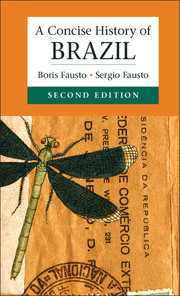Book contents
- Frontmatter
- Dedication
- Contents
- List of Maps
- Preface
- Map
- 1 Colonial Brazil (1500–1822)
- 2 Imperial Brazil (1822–1889)
- 3 The First Republic (1889–1930)
- 4 The Vargas State (1930–1945)
- 5 The Democratic Experiment (1945–1964)
- 6 The Military Government and the Transition to Democracy (1964–1984)
- 7 Modernization under Democracy (1985–2010)*
- Bibliography
- Index
1 - Colonial Brazil (1500–1822)
Published online by Cambridge University Press: 05 August 2014
- Frontmatter
- Dedication
- Contents
- List of Maps
- Preface
- Map
- 1 Colonial Brazil (1500–1822)
- 2 Imperial Brazil (1822–1889)
- 3 The First Republic (1889–1930)
- 4 The Vargas State (1930–1945)
- 5 The Democratic Experiment (1945–1964)
- 6 The Military Government and the Transition to Democracy (1964–1984)
- 7 Modernization under Democracy (1985–2010)*
- Bibliography
- Index
Summary
Overseas Expansion and the Portuguese Arrival in Brazil
The Portuguese reached the coast of what today is Brazil in April 1500. This occurrence was but one of the many episodes of Portuguese overseas expansion, which began early in the 15th century.
Why did a tiny country such as Portugal begin its expansion at the beginning of the 15th century, almost 100 years before Columbus, sailing for Spain, reached the Americas? There is more than one answer to this question, and, to answer it, a number of factors should be taken into account. In the first place, Portugal had distinguished itself among the European nations as an independent country with a tendency to look beyond its borders. Even though they were still no rivals for Venetians and Genoese, whom they would eventually surpass during the 13th and 14th centuries, the Portuguese had accumulated considerable experience in long-distance trade. Besides, before the Portuguese took control of their own international trade, Genoa had invested in their expansion and had made Lisbon a major center of its commercial endeavors.
- Type
- Chapter
- Information
- A Concise History of Brazil , pp. 1 - 74Publisher: Cambridge University PressPrint publication year: 2014

